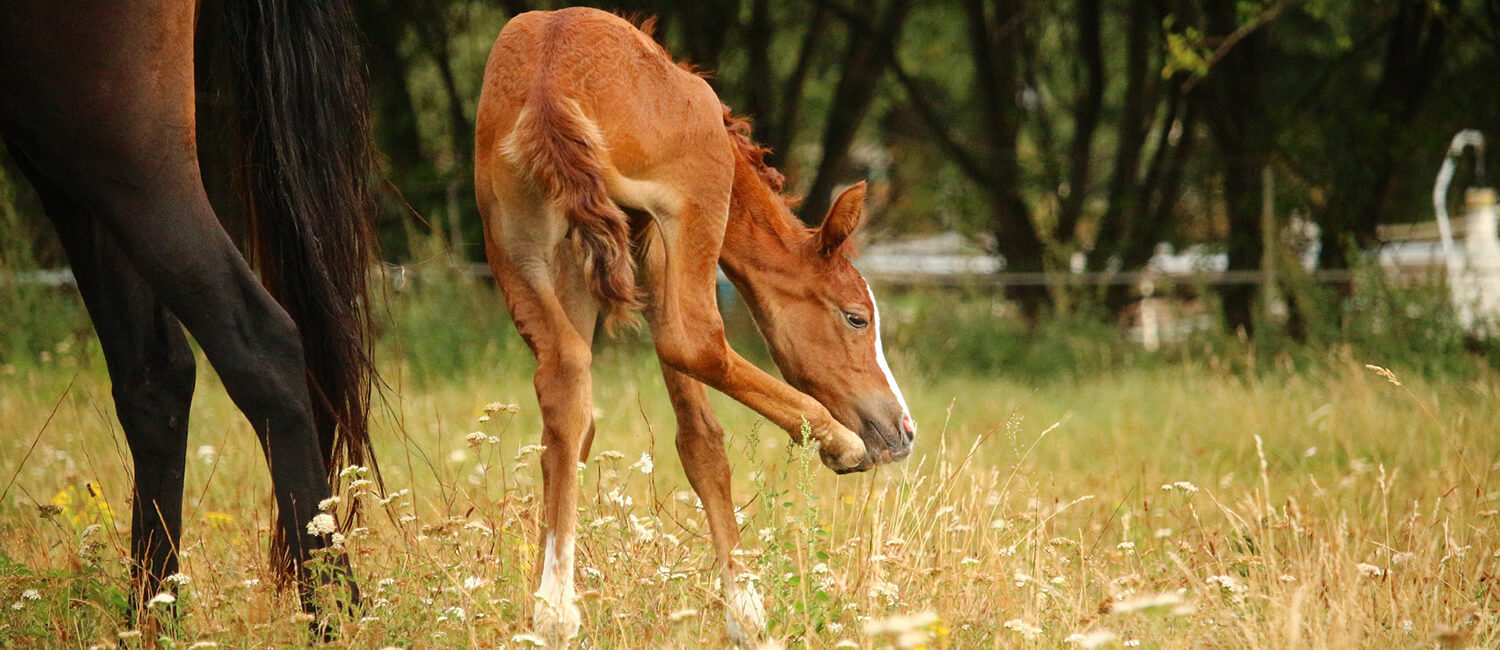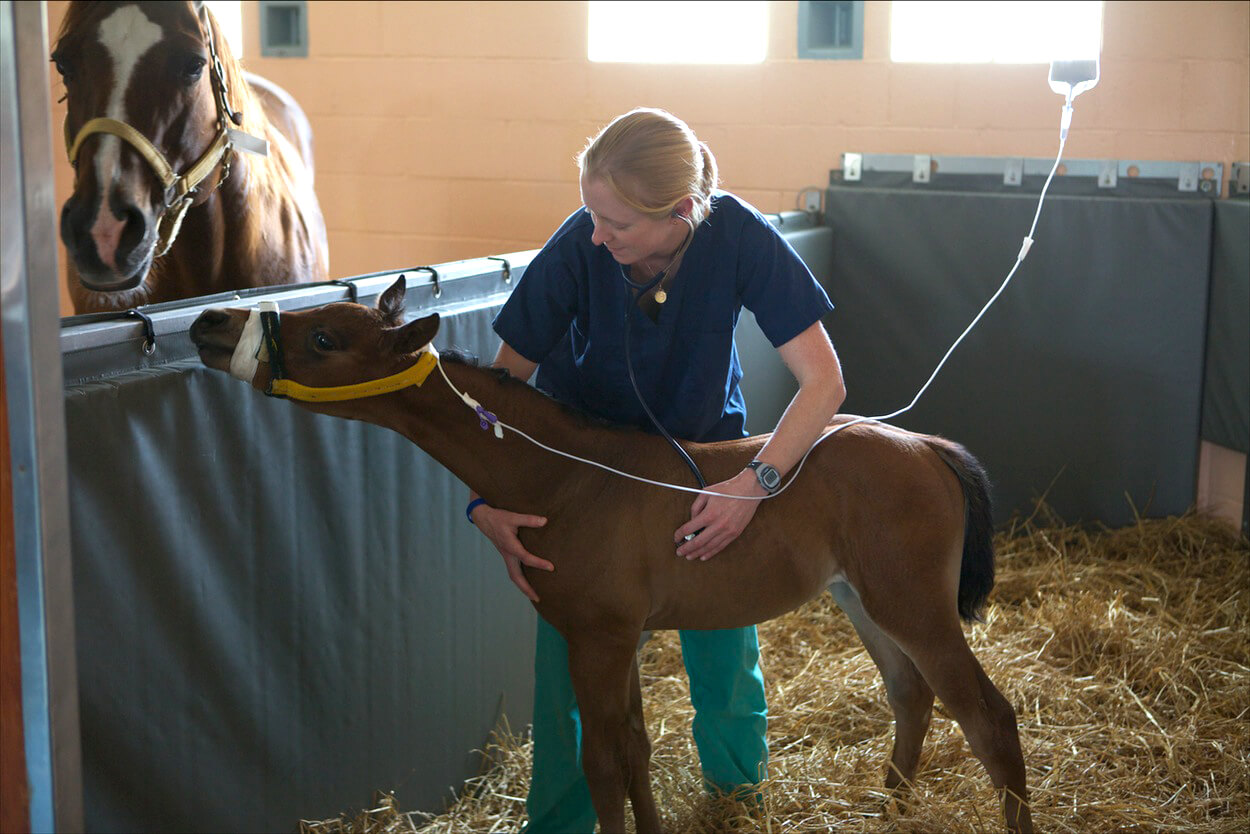
From December to August, breeding and foaling season, Dr. Michelle Abraham has her hands full with pregnant mares and foals.
“During this time, my obstetric and neonatal cases fall under a few categories,” said Abraham, a staff veterinarian of Internal Medicine and Emergency and Critical Care, and a specialist in equine Neonatal Intensive Care. “There are uneventful pregnancies and births and more difficult cases. Common issues include high-risk pregnancies, difficult births, foals born to mares with placentitis, premature deliveries, and foals who develop colic, sepsis, and/or diarrhea in the days after birth.” Horses, she added, are considered foals until they are weaned, which can occur anywhere from 4–7 months of age.
Abraham and New Bolton Center’s critical care and internal medicine team offer services for mares and foals onsite at Penn Vet. The Healthy Mare Foaling Program provides 24/7 observation of late-gestation mares. The Graham French Neonatal Intensive Care Unit specializes in high-risk pregnancies and critically ill foals. Additionally, the hospital’s Equine Field Service can treat foals on the farm.
“A healthy foal begins with a healthy mare,” Abraham explained. “Penn Vet’s facilities and personnel are at the forefront of neonatal intensive care, and we have world class specialists in all areas of equine medicine. New Bolton Center patients receive the best care possible at the hands of exceptional doctors and nurses and amazing volunteers.”
 Dr. Michelle Abraham cares for a foal in the Graham French Neonatal Intensive Care Unit.
Dr. Michelle Abraham cares for a foal in the Graham French Neonatal Intensive Care Unit.
Ten Things to Do for Mom and Foal
To set horses up for success, Abraham offers a list of ten things owners can do. The following information is not a substitute for medical advice. “Call a veterinarian any time you’re worried about anything,” said Abraham. “Even before there’s an issue, develop a close relationship with your veterinarian to establish goals for your horse and understand when to seek veterinary help.”
During pregnancy, contact your veterinarian immediately if your mare is dripping milk leading up to foaling. She may be at risk of losing a significant amount of colostrum. Also known as the “first milk,” colostrum is filled with antibodies critical to a foal’s developing immune system. A poor supply of colostrum puts the neonate at higher risk of infections.
Remember the 1-2-3 rule. 1: Foals should stand by one hour of age. 2: Foals should successfully nurse by two hours of age. 3: Mares should pass her fetal membranes within three hours of delivery.
Have a “new foal veterinary exam” within 24 hours after birth. During this exam, your veterinarian should conduct a newborn checkup. A general physical exam should be performed, and when the foal is between 18-24 hours of age an IgG test should be performed. This is to ensure the foal has received enough colostrum from the mare. The result should be greater than 800 mg/dl, with most healthy foals in the 1000–2000 mg/dl range.
Your veterinarian or an experienced person should also evaluate the fetal membranes to ensure they’re intact. Mares who retain even the smallest portion of the fetal membranes can become incredibly sick.
Allow mare and foal to bond. If foaling went without issue, give the mare and foal time to bond. As hard as it is to resist, don’t invite the entire neighborhood over immediately after the foal is born. There’s a very short time from birth to when you want the foal to stand and nurse. Anything that derails these milestones can potentially cause problems later. The mare also needs time to rest, free from the stress of onlookers and visitors. A great, unobtrusive way to keep an eye on mom and baby is a stall camera.
Maintain good hygiene around the barn and stall. Wash foaling equipment/kits after each foaling. Clean the mare’s udder before her foal nurses. Avoid sticking your fingers in the foal’s mouth—not only can it distract a foal from learning to stand and nurse, but human hands carry many pathogens. Foals have weak immune systems when they are first born, so while pathogens may be harmless to us and older foals, they can be problematic to newborns if ingested.
Watch for and encourage meconium passage. This is the first manure a foal passes. Some foals get very distracted and tired when they’re putting effort into passing meconium. An enema can help them and allow them time and energy to focus on standing and nursing. Talk to your vet in advance about enemas to have on hand and how to administer them.
Start handling a foal once everything settles down. Acclimating a foal to human touch is important and can make your life much easier when the foal is bigger. Make sure early touch is a positive experience—don’t force it! The environment should be quiet, calm, and near the mare. Work with the foal for short periods each day. Find where he or she likes to be scratched—often the base of the neck is a good place. I also like to teach foals to pick up their feet early so it becomes part of their day-to-day life.
Always be careful not to humanize a foal. Don’t over-handle the animal—the foal needs to understand you are not a playmate. Horse play is dangerous for you when the horse is fully grown!
Get mare and foal outside as soon as they’re healthy and strong enough. Start them in a small paddock for short periods and gradually building up to more space. This is as much for mom as it is for foal. The mare’s uterus will expel the remainder of fetal fluids and return to its pre-pregnancy state faster with turnout.
And last, but certainly not least, enjoy your new foal!